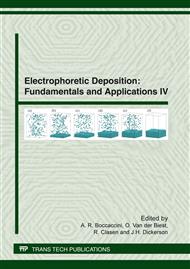p.27
p.35
p.41
p.47
p.53
p.61
p.67
p.73
p.79
Fundamentals of Pulsed and Direct Current Electrophoretic Infiltration Kinetics
Abstract:
The present research endeavors to demonstrate the applicability of electrophoretic deposition (EPD) for the infiltration and coating of porous materials to create advanced composites. Motivated by improved materials requirements of tokamak fusion reactors, the composites are created by depositing ceramic nanoparticles in porous metallic matrices using both constant voltage and pulsed DC EPD. Silicon dioxide particles with a nominal diameter of 20 nm are used as inexpensive surrogates for more application-appropriate boron carbide due to their similar surface chemistry. Fabricated materials are characterized using scanning electron microscopy (SEM) and energetic dispersive x-ray spectrometry (EDX) to visualize coating quality and penetration of the material into the substrate. At low voltage, the deposited mass in constant voltage EPD increases linearly with time while at high voltage it asymptotically approaches a maximum yield of 1.988 grams. Pulsed EPD experiments demonstrate a reduction in deposition yield but also elimination of macro-pore generation in the low voltage case. A non-dimensional parameter, ξ*, relating electrokinetics and diffusion is derived which improves process design for pulsed EPD systems.
Info:
Periodical:
Pages:
53-57
Citation:
Online since:
March 2012
Authors:
Price:
Сopyright:
© 2012 Trans Tech Publications Ltd. All Rights Reserved
Share:
Citation:


